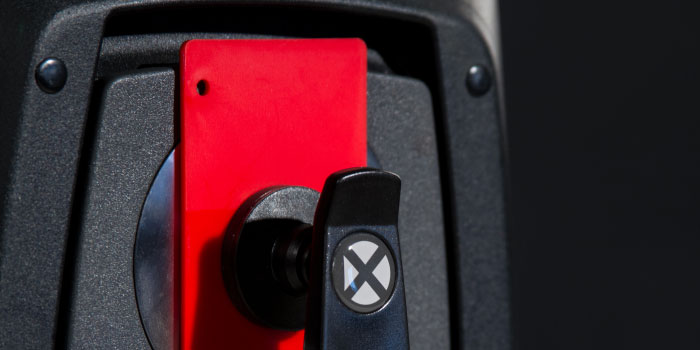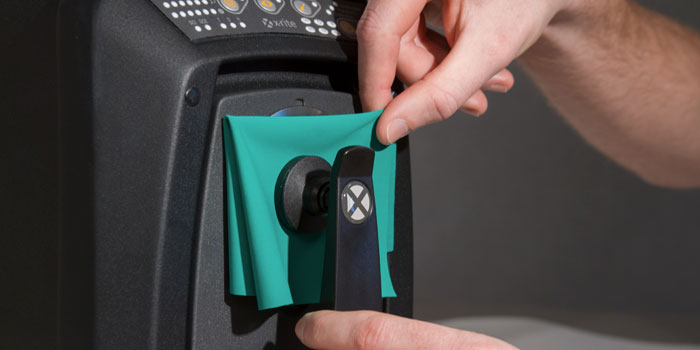Benchtop spectrophotometers measure in transmission and/or reflectance mode to capture and quantify color on opaque, transparent, and translucent samples. Reflectance spectrophotometers measure color by flashing light onto the surface of the sample and measuring the percentage of spectral reflectance of different wavelengths at 10 nanometer increments.

This blog explains how a spectral reflectance measurement works so you can determine if it will meet your color measurement and quality control needs.
How to Measure Reflectivity or Reflectance
To capture color measurements in reflectance mode, a spectrophotometer emits all the wavelengths of light (wavelength range from 360 -750) through the flash, then measures the light reflected back to create a quantified graph of that color. The dominant wavelengths that reflect back indicate the color. Purples, indigos, and blues have a shallow wavelength range from 400 – 550. Greens are in the middle, with a wavelength range from 550 – 600. Yellows, oranges, and reds provide the longest visible wavelengths. OBAs and fluorescent agents – the outliers – peak at over 100%.

When to Use Reflectance Measurements
If you’re measuring surfaces that are completely opaque, a reflectance spectrophotometer can do the job. Since spectral reflectance instruments capture reflected light, they provide the most accurate and reproducible results for flat, matte surfaces. A little shininess is OK, but mirror-like surfaces will yield inaccurate readings. That's because mirror-like surfaces have high specular reflectivity, where the incident light reflects the same way.
Paint Samples
Most paint will cover the substrate so you can’t see through it, but you would need to analyze the paint using the contrast ratio method to see if it is truly opaque. Paints that are opaque once applied to a substrate are a good candidate for reflectance color measurements.
Plastic Samples
While we may not be able to see through a plastic sample, it may have the ability to transmit light. If you hold a strong light up to it and some light shines through, a transmission spectrophotometer is a better choice.
If you’re a smaller molder or plastics processor who strictly works with opaque materials, you may be able use reflectance measurements. If you’re a plastics processor who needs the ability to also measure translucent items like thin films, you probably need a transmission spectrophotometer.

Textile Samples
AATCC recommends folding samples into four surfaces to gain opacity for accurate reflectance surface measurements. While this will work for corduroy or thick cotton fabric, a transmission spectrophotometer might be a better choice for a sheer or thin semi-transparent nylon material.

X-Rite's Transmission and Reflectance Measurement Spectrophotometers
Transmission and Reflectance Measurements
While you can measure surfaces that transmit light in reflection mode, you must be aware of the translucency of the sample. The Ci7000 Series of benchtop sphere reflectance measurement spectrophotometers includes four models to meet a variety of color measurement needs, all of which conform to ASTM D2244. The Ci7600, Ci7800, and Ci7860 benchtops measure in both transmission and reflectance modes, ideal if you measure both opaque and translucent samples.
Reflectance Measurements Only
If you only need to capture surface color measurements of opaque materials like painted parts, the Ci7500 spectrophotometer may be a good choice. This introductory model in the series is a cost effective spectrophotometer that only measures in reflectance mode.
If you need a device that can capture both surface reflectance and transmission measurements, the Ci7500 will not work for you.

For example:
- Many paint applications select benchtops because they are highly accurate, but don’t necessarily need to measure transmission. If you will never encounter the need for transmission measurements, the Ci7500 may be an economical choice.
- If you’re just measuring men’s ties or leather, the Ci7500 may be sufficient to capture surface measurements. However, if you measure materials like solar sails, outdoor umbrellas, or beach tents for children, they appear opaque but must be tested for light blocking capabilities so the Ci7500 will not work. The Ci7600 and higher conform with ASTM test method 203 of light blocking procedures.

Still not sure if you need a reflectance or transmission spectrophotometer? Read our blog for more information.
Learn More
We know choosing the right benchtop is not an easy decision, especially when it comes to understanding complicated terms like reflectance, reflected light, incident light, diffuse reflectance, reflectance values, diffusely reflected light, and transmission measurements.
Contact us to discuss the color measurement and quality control needs for your intended application and one of our Color Experts can help.
Additional Spectrophotometer Resources
Blogs
- What is a Spectrophotometer?
Spectrophotometers quantify reflected or transmitted light across the spectrum and create a visual reflectance curve that exactly describes a color.
- What Does a Spectrophotometer Measure?
A spectrophotometer is an instrument that measures color by shining a beam of light and capturing the amount of light that reflects back or transmits through to quantify color.
- Choosing a Spectrophotometer for Print and Packaging
While popular for print and packaging, reflective surfaces and metallic inks make color control a challenge. Learn about measurement options to control them.
- Spectrometer vs. Spectrophotometer: What's the Difference?
With such a minute spelling difference, it's easy to make a typo and get the wrong answer for your question. Here is the difference between a spectrometer and a spectrophotometer.
Whitepapers
- What Spectrophotometer Type Is Best For You?
Download this whitepaper to learn which type of spectrophotometer is best for you based on the surface you are measuring.
- Ci7000 Series: A Legacy of Innovation
Learn how the Ci7000 Series of benchtop spectrophotometers has set the new standard for color control for even the most complex plastics, textiles, paints and coatings.
- Keep Your Spectrophotometer in Excellent Health
Many different types of errors occur in spectrophotometric measurements, in this whitepaper learn how NetProfiler, a system of software and color standards, can correct these errors.
Webinars
- The Infinite World of Spectrophotometers
Watch this webinar to gain a deeper understanding of color measurement and the primary tool that enables accurate color measurement – a spectrophotometer.
- Which Benchtop is Right for My Workflow?
In this webinar, we will review what factors that you should take into consideration when deciding between different types of benchtop spectrophotometer.
- Ci7000 Series Benchtop Spectrophotometers: Are They Worth the Upgrade?
Join us for this webinar when Color Expert Tim Mouw will outline the benefits of upgrading to the latest Ci7800 Series benchtop sphere spectrophotometer for your needs.
- How to Effectively Manage Your Fleet of Instruments
Watch this webinar to learn how you can more effectively and efficiently manage measurements and performance of a single or fleet of spectrophotometers.
- Optimize and Validate the Performance of Your Spectrophotometers
This 30-minute webinar will explain how to use NetProfiler to validate the performance of your spectrophotometers and ensure consistency across your supply chain fleet.
